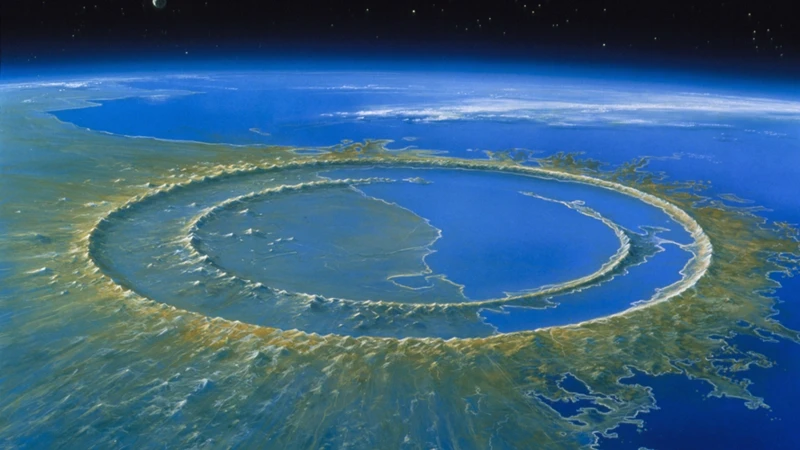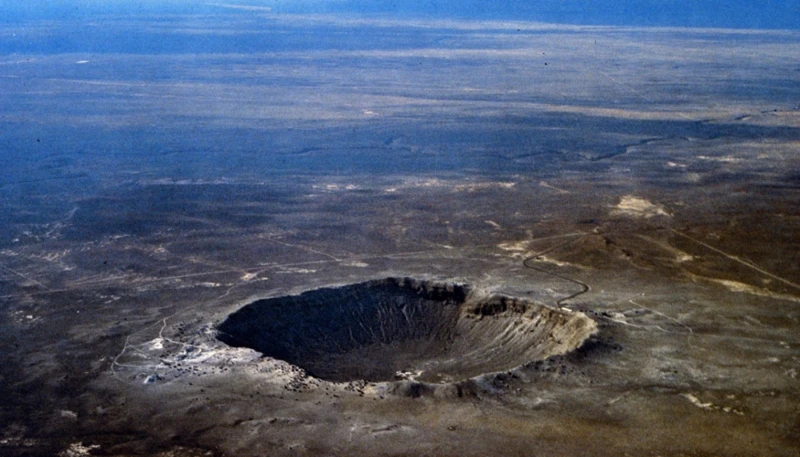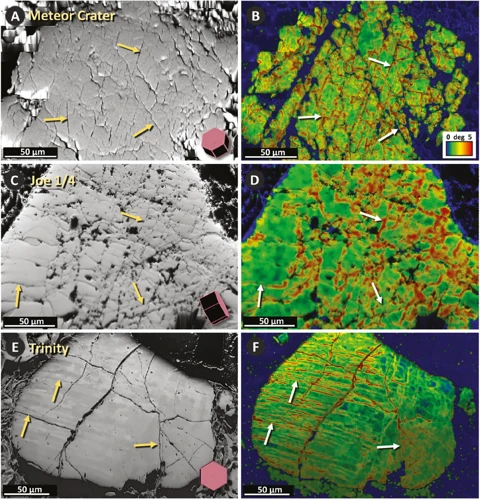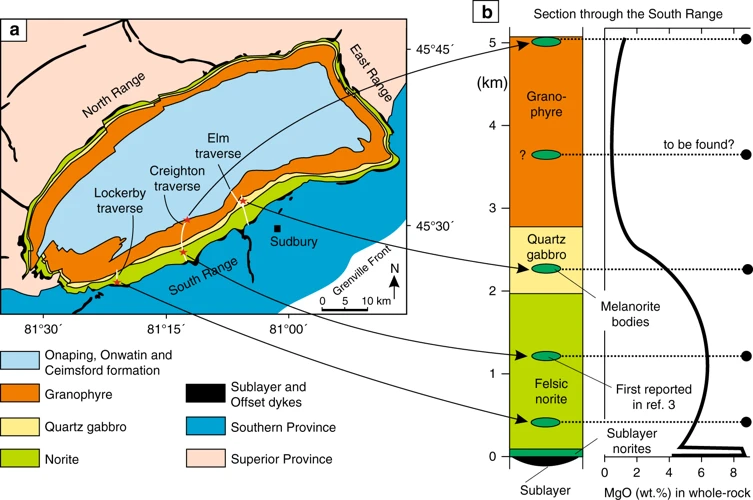When we gaze up at the night sky, we are often in awe of the vastness and beauty of the universe. But what we may not realize is that our very own planet has been impacted by asteroids, leaving behind craters that tell a story of cosmic collisions. These famous asteroid impact craters on Earth are not only fascinating but also provide valuable insights into our planet’s geological history. In this article, we will delve into the intriguing details of four remarkable impact craters: the Chicxulub Crater, the Barringer Crater, the Vredefort Crater, and the Sudbury Crater. Let’s embark on a journey to uncover the mysteries and significance of these extraordinary landmarks.
Contents
- The Chicxulub Crater
- The Barringer Crater
- The Vredefort Crater
- The Sudbury Crater
- Conclusion
-
Frequently Asked Questions
- 1. How was the Chicxulub Crater discovered?
- 2. What caused the formation of the Barringer Crater?
- 3. How did the Vredefort Crater earn its status as a UNESCO World Heritage Site?
- 4. What makes the Sudbury Crater’s geological features unique?
- 5. How did the impact that formed the Chicxulub Crater affect the global climate?
- 6. What is the composition of the rocks found in the Barringer Crater?
- 7. How does the Vredefort Crater provide insights into Earth’s geological history?
- 8. Can visitors explore the Barringer Crater?
- 9. What is the estimated age of the Sudbury Crater?
- 10. How did the impact that formed the Vredefort Crater affect the surrounding landscape?
- References
-
Frequently Asked Questions
- 1. How many famous asteroid impact craters are there on Earth?
- 2. What is the largest asteroid impact crater on Earth?
- 3. How old is the Chicxulub Crater?
- 4. Is the Barringer Crater still an active impact site?
- 5. Are there any significant geological features within the Sudbury Crater?
- 6. Is the Vredefort Crater a UNESCO World Heritage Site?
- 7. What are the major implications of the Chicxulub Impact?
- 8. Can the Barringer Crater be visited by tourists?
- 9. How did the Sudbury Crater contribute to the mining industry?
- 10. What makes the Vredefort Crater scientifically significant?
- References
- Read More
The Chicxulub Crater

The Chicxulub Crater, located in the Yucatán Peninsula, Mexico, is an extraordinary landmark with a captivating story. This impact crater, measuring approximately 180 kilometers in diameter, was formed around 66 million years ago during the end-Cretaceous period. The discovery of this crater played a crucial role in unraveling the mystery behind the extinction of the dinosaurs. Scientists believe that the impact of a massive asteroid, estimated to be about 10 kilometers in diameter, caused widespread devastation, including tsunamis, earthquakes, and a global firestorm. The consequences were catastrophic, leading to the extinction of about 75% of all species on Earth, including the dinosaurs. The significance of the Chicxulub Crater lies not only in its impact on Earth’s history but also in its role in shaping the evolution of life as we know it today. It serves as a constant reminder of the /gemini-twins-intriguing-story/ interplay between celestial bodies and our planet’s existence.
1. Discovery and Formation
The discovery and formation of the Chicxulub Crater are a fascinating tale that sheds light on the ancient collision that shaped our planet. The existence of this impact crater was first proposed by geophysicists Glen Penfield and Antonio Camargo in the late 1970s. Their investigation was prompted by an anomaly they noticed in geophysical data collected for oil exploration in the Yucatán Peninsula. Further research revealed the presence of a large circular structure buried beneath layers of rocks and sediments. This finding led to the realization that the Chicxulub Crater was formed by the impact of a massive asteroid. The main piece of evidence that cemented this theory was the discovery of unique geological features, such as shocked quartz and impact glass, in rocks drilled from the crater’s center. These rocks contained unmistakable signs of the immense pressure and heat generated during the impact event. The formation of the Chicxulub Crater is believed to have occurred when the asteroid, traveling at a staggering speed, collided with Earth. This collision released an inconceivable amount of energy, equivalent to billions of atomic bombs, causing widespread devastation in the surrounding area. The impact created a massive crater and ejected an enormous volume of debris into the atmosphere, ultimately affecting the entire planet. The fascinating story of the discovery and formation of the Chicxulub Crater serves as a reminder of the /significance-sextilles-astrological-aspects/ profound influence that celestial events can have on our planet.
2. The Impact’s Consequences
The consequences of the Chicxulub impact were widespread and had a profound impact on the Earth’s environment and the evolution of life. Here are some key points about the impact’s consequences:
1. Global Firestorm: The intense heat generated by the impact caused widespread forest fires around the world. The resulting smoke and ash filled the atmosphere, blocking sunlight and causing a significant drop in temperature, leading to an extended period of darkness and a global winter-like climate.
2. Mass Extinction: The Chicxulub impact is widely believed to have been one of the main causes of the Cretaceous-Paleogene (K-Pg) extinction event, which resulted in the extinction of approximately 75% of all species on Earth, including the dinosaurs. The immediate aftermath of the impact caused a massive disruption in the ecosystem, wiping out countless marine and terrestrial species.
3. Tsunamis and Flooding: The impact triggered colossal tsunamis, with waves reaching hundreds of meters in height. These tsunamis devastated coastal regions, causing widespread flooding and wiping out entire ecosystems along the coast.
4. Climate Change: The massive amount of debris and dust injected into the atmosphere by the impact caused global climate change. The dust cloud blocked sunlight, leading to a significant drop in temperature worldwide. This drastic climate change had long-lasting effects on the Earth’s ecosystems, resulting in the reshaping of vegetation patterns and the extinction of many species.
5. Opportunity for Evolution: While the impact had devastating consequences, it also created new opportunities for the evolution and diversification of life on Earth. With the extinction of dominant species, new ecological niches opened up, allowing for the emergence and expansion of new species, ultimately leading to the rise of mammals as the dominant animals on the planet.
The consequences of the Chicxulub impact continue to be studied by scientists and have provided invaluable insights into the history of our planet and the impact events that shape it. It serves as a reminder of the profound influence that celestial events can have on our planet and its inhabitants. To delve deeper into the mysteries of the universe, /the-enigmatic-nature-of-dark-matter/ is a fascinating topic that explores the enigmatic nature of dark matter and its role in the cosmos.
3. Scientific Significance
The Chicxulub Crater holds immense scientific significance due to its role in shaping our understanding of planetary dynamics and the impact of celestial events on Earth’s ecosystems. The study of this impact crater has provided crucial insights into the mechanics of massive asteroid impacts and their consequences. Scientists have been able to reconstruct the sequence of events that occurred during the impact, from the initial crater formation to the subsequent environmental changes.
One of the remarkable discoveries linked to the Chicxulub Crater is the identification of the impact winter phenomenon. The massive release of dust, soot, and gases into the atmosphere from the impact resulted in a global cooling effect. This cooling led to a decrease in sunlight reaching the Earth’s surface, causing a disruption in the planet’s climate system. By studying the geological records present within the crater, scientists have gained valuable insights into the long-term effects of such an impact on the Earth’s climate and ecosystems.
The Chicxulub Crater has provided a fertile ground for the study of extremophile microorganisms. These microorganisms thrive in extreme environments and have been found in the crater’s impact breccia, providing evidence of life’s ability to adapt and survive even in the aftermath of catastrophic events. The study of these extremophiles has broadened our understanding of the potential for life on other planets and moons within our solar system.
Additionally, the impact of the Chicxulub asteroid led to the creation of unique hydrothermal systems within the crater. These hydrothermal systems offer scientists the opportunity to study the physical and chemical conditions necessary for the emergence and sustenance of life. Through the exploration of these extraordinary environments, researchers hope to gain insights into the origins of life on Earth and the potential for life in similarly extreme conditions elsewhere in the universe.
The scientific significance of the Chicxulub Crater lies in its contribution to our understanding of planetary dynamics, climate disruption caused by asteroid impacts, the resilience of life in extreme environments, and the potential for life beyond Earth. By studying this remarkable impact crater, scientists continue to expand our knowledge of the intricate relationship between celestial events and the evolution of our planet.
The Barringer Crater

The Barringer Crater, also known as Meteor Crater, is a remarkable asteroid impact crater located near Winslow, Arizona, United States. It is one of the best-preserved impact craters on Earth, with a diameter of approximately 1.2 kilometers and a depth of around 170 meters. This crater was formed around 50,000 years ago when a nickel-iron meteorite, estimated to be about 50 meters in diameter, collided with the Earth’s surface at a speed of about 12.8 kilometers per second. The impact released an immense amount of energy, excavating the crater and causing widespread devastation in the surrounding area. The Barringer Crater is composed of layers of shattered rocks and fragmented meteorite material, which provide valuable insights into the dynamics of asteroid impacts and the processes that shape terrestrial landscapes. Today, this unique geological feature serves as a popular tourist attraction, allowing visitors to witness firsthand the awe-inspiring power of our planet’s history and the forces that shape it.
1. Unveiling the Mysteries
Unveiling the mysteries surrounding the Barringer Crater has been a fascinating endeavor for scientists and researchers. This impact crater located in Arizona, USA, has sparked curiosity due to its unique features and origin story. The primary mystery surrounding the Barringer Crater, also known as Meteor Crater, is its apparent lack of a significant meteorite. Despite extensive exploration, no large meteorite fragments have been found within the crater. This has led to various theories regarding the impact event itself. Some scientists speculate that the meteorite, estimated to have been approximately 50 meters in diameter, completely vaporized upon impact, leaving behind no remnants. Others propose that the impacting body disintegrated upon entry into the Earth’s atmosphere, resulting in smaller fragments dispersing over a wide area. While the mystery of the missing meteorite remains unresolved, the Barringer Crater continues to captivate visitors and researchers alike with its undeniable evidence of a powerful cosmic event. Its unique characteristics and enigmatic history make it a subject of ongoing scientific inquiry and a testament to the enigmatic nature of dark matter and the profound influence celestial bodies have on our planet.
2. Formation and Composition
The Barringer Crater, also known as Meteor Crater, is a remarkable example of an impact crater formed by a meteorite impact. The formation of this crater dates back approximately 50,000 years, when a nickel-iron meteorite, about 50 meters in diameter and weighing millions of tons, hurtled towards Earth at a speed of about 40,000 miles per hour. Upon impact, the immense energy released vaporized the meteorite and melted the rocks in the vicinity. The intense heat caused the rocks to behave like a fluid, resulting in the formation of the characteristic bowl-shaped crater. The impact also shattered and ejected rock fragments, creating a unique feature known as the ejecta blanket. The composition of the Barringer Crater is predominantly made up of fragments of the meteorite along with rocks from the Earth’s surface that were dislodged during the impact. The fusion of these materials created a distinct layer of breccia, a type of rock formed from angular fragments cemented together by impact-related processes. This composition provides valuable insights into the nature of meteorites and the geological processes associated with impact events. It emphasizes the dynamic relationship between celestial bodies and the Earth, shaping its landscape in extraordinary ways.
3. A Tourist Attraction
One remarkable aspect of the Barringer Crater is its popularity as a tourist attraction. Visitors from all around the world travel to Arizona, United States, to witness this awe-inspiring natural phenomenon. The crater offers a unique experience for tourists who are fascinated by the wonders of space and the impact of celestial bodies on our planet. There are several ways to explore the Barringer Crater, including guided tours and self-guided hikes around the rim. Visitors can marvel at the sheer size of the crater, which spans over 1.2 kilometers in diameter and is approximately 170 meters deep. Along the rim, there are informative plaques and exhibits that provide insights into the formation of the crater and its geological significance. Additionally, there is a visitor center that offers educational displays, interactive exhibits, and a viewing platform that offers breathtaking panoramic vistas of the crater. Some visitors even choose to take helicopter tours for a more immersive experience, flying over the crater and getting a bird’s-eye view of this incredible geological feature. The Barringer Crater is not only a site of scientific interest but also a fascinating destination for those seeking to witness the remnants of an asteroid impact firsthand.
The Vredefort Crater

The Vredefort Crater, located in South Africa, is not just any ordinary crater. With a diameter of approximately 300 kilometers, it holds the distinction of being the largest confirmed impact crater on Earth. This immense crater was formed over two billion years ago when a massive asteroid, estimated to be about 10 kilometers in diameter, collided with our planet. The impact was so colossal that it caused the Earth’s crust to rebound, creating an unmistakable dome-shaped structure. Today, the Vredefort Crater stands as a testament to the sheer power of these cosmic collisions. It is not only a scientific marvel but also a UNESCO World Heritage Site, recognized for its geological significance and the insight it provides into the Earth’s geological evolution over billions of years. The Vredefort Crater is a window into our planet’s turbulent past, reminding us of the enigmatic forces that have shaped our world.
1. A Record-breaking Impact
In the realm of asteroid impacts, the Vredefort Crater in South Africa stands out as a record-breaking event. It is classified as the largest confirmed impact crater on Earth, with a diameter of approximately 300 kilometers. The impact occurred roughly 2 billion years ago when an enormous asteroid or comet, estimated to be about 10 kilometers in diameter, struck the Earth’s surface with unimaginable force.
The energy released during this cataclysmic event is mind-boggling. Scientists estimate that the impact produced an explosion equivalent to billions of atomic bombs. The intense heat generated by the impact melted the rocks in the vicinity, creating a molten crater that eventually solidified into a central uplift, characteristic of large impacts. The shockwaves generated by the impact traveled thousands of kilometers, causing widespread destruction.
Despite the immense size of the Vredefort Crater, it is worth noting that its original dimensions were likely much larger. Over the course of billions of years, geological processes such as erosion and tectonic activity have worn down the crater’s edges, reducing its visible size. Nonetheless, the Vredefort Crater remains an awe-inspiring testament to the powerful forces that shape our planet and the universe.
2. Geological Significance
The Vredefort Crater holds immense geological significance. This crater, located in South Africa, is the largest known and oldest impact crater on Earth. It was formed approximately 2 billion years ago when a massive asteroid, estimated to be about 10 kilometers in diameter, collided with the Earth’s surface. The impact was so powerful that it caused the rocks in the area to become deeply deformed, creating what is known as a central uplift. This central uplift is a unique geological feature that can be seen within the crater. It consists of a dome-shaped structure formed by the rebound of the rocks after the impact. The Vredefort Crater provides valuable insights into the processes of large-scale geological deformation and the formation of impact craters. It has contributed greatly to our understanding of planetary geology and has been instrumental in shaping the field of impact crater research. The geological evidence found within the Vredefort Crater has helped scientists study the effects of asteroid impacts on Earth’s surface and the long-term geological consequences that follow. This crater serves as a reminder of the /the-enigmatic-nature-of-dark-matter/ powerful forces that have shaped our planet throughout its history.
3. UNESCO World Heritage Site
The Vredefort Crater holds the prestigious title of being a UNESCO World Heritage Site. This recognition highlights its exceptional scientific and geological importance. The crater, located in the Free State province of South Africa, is the largest verified impact crater on Earth, with a diameter of approximately 300 kilometers. Its formation dates back around 2 billion years, making it one of the oldest known impact structures on our planet. The Vredefort Crater provides valuable insights into the processes that occur during the impact of large celestial bodies. It showcases a stunning array of geological features, including uplifted rock layers and shock metamorphism. These features have been meticulously studied by scientists to enhance our understanding of impact cratering and Earth’s geological evolution. The site is not only a scientific treasure but also a visually striking landscape, attracting visitors from around the world. The recognition as a UNESCO World Heritage Site ensures its preservation and promotes further research on the dynamics of asteroid impacts and their long-term effects.
The Sudbury Crater

Located in Ontario, Canada, the Sudbury Crater is a remarkable impact crater that holds both geological and economic significance. Formed around 1.85 billion years ago, this crater is one of the oldest known impact structures on Earth, spanning approximately 250 kilometers in diameter. One of the most intriguing aspects of the Sudbury Crater is its rich ore deposits, including nickel, copper, and platinum group metals. These deposits have made the region a significant player in the mining industry, contributing to Canada’s economic prosperity. In addition to its economic importance, the Sudbury Crater boasts unique geological features, such as the Sudbury Igneous Complex, which provides valuable insights into the Earth’s ancient past. The enigmatic nature of the Sudbury Crater continues to intrigue scientists and visitors alike, reminding us of the profound impact celestial events can have on both the natural world and human endeavors.
1. A Rich Ore Deposit Impact
The Sudbury Crater, known as a top destination for geologists and mining enthusiasts, has an intriguing feature that sets it apart – it is a rich ore deposit impact. When the meteorite struck the Earth about 1.8 billion years ago, it caused immense heat and pressure that led to the formation of valuable mineral deposits. The impact created a unique geological phenomenon known as the Sudbury Igneous Complex, which contains a vast amount of nickel, copper, and other precious metals. The meteorite’s composition, rich in these minerals, became a valuable resource that has been extensively mined in the Sudbury area. In fact, the Sudbury Crater is recognized as one of the largest ore-producing regions in the world. The discovery of these rich ore deposits had a profound impact on the mining industry, attracting both national and international attention. This impact event not only shaped the local economy but also contributed to advancements in mining technology and techniques. The Sudbury Crater stands as a testament to the /significance-sextilles-astrological-aspects/ crucial role of celestial events in Earth’s geological history, leaving behind a legacy of valuable minerals that continue to support global industries.
2. Unique Geological Features
The Sudbury Crater is not only known for its rich ore deposits and impact on the mining industry but also for its unique geological features. One of the most fascinating geological features of the Sudbury Crater is the presence of an impact melt sheet, which is a layer of rock created by the intense heat and pressure generated from the impact. This melt sheet, composed of molten rock, covers an area of approximately 1,600 square kilometers and is several kilometers thick.
Another distinctive geological feature is the presence of shatter cones in the surrounding bedrock. Shatter cones are cone-shaped fractures that form when the shockwaves from the impact travel through the rock, causing it to fracture in a distinctive pattern. These shatter cones can be found in the crater and are used by scientists as evidence of the impact event.
Additionally, the Sudbury Crater is known for its breccia deposits. Breccia is a type of rock composed of fragmented material that has been cemented together. The impact of the asteroid created a chaotic mix of rocks and minerals, resulting in the formation of these breccia deposits in and around the crater.
The unique geological features of the Sudbury Crater provide valuable insights into the dynamics of asteroid impacts and the subsequent geological processes that occur. Studying these features helps scientists better understand the formation and aftermath of large-scale impact events, contributing to our knowledge of Earth’s history and its interactions with celestial bodies.
3. Impact on Mining Industry
The Sudbury Crater has had a significant impact on the mining industry. The crater, located in Ontario, Canada, is one of the largest impact structures on Earth, measuring approximately 130 kilometers in diameter. It was formed around 1.85 billion years ago as a result of a meteorite impact. The unique geological features of the Sudbury Crater have made it one of the most productive mining areas in the world. It is rich in nickel, copper, and other valuable minerals, which have been commercially exploited for decades. The mining industry in Sudbury has thrived due to the abundance of these resources, contributing to the economic growth of the region. The impact crater has become a hub for mining operations and has resulted in the establishment of numerous mines, providing employment opportunities for many. Additionally, the Sudbury Crater has played a crucial role in advancing our understanding of ore deposits and geological processes. Scientists and geologists study the structure and composition of the crater to gain insights into mineral formation and the dynamics of impact cratering. The impact of the Sudbury Crater on the mining industry has been twofold: it has propelled the economic development of the region while also serving as a valuable research site for geological studies.
Conclusion

In conclusion, the famous asteroid impact craters on Earth are not just scars on our planet’s surface; they are windows into our planet’s past and the cosmic events that have shaped it. The Chicxulub Crater, with its link to the extinction of dinosaurs, reminds us of the delicate balance of life on Earth and the potential consequences of celestial collisions. The Barringer Crater, a popular tourist attraction, showcases the power of impact events and the lasting impact they have on our planet. The Vredefort Crater, a UNESCO World Heritage Site, reveals geological marvels and geological events that are unparalleled in their scale. The Sudbury Crater, with its rich ore deposits and unique geological features, demonstrates how asteroid impacts can have lasting effects on industries such as mining. These craters serve as reminders of the dynamic nature of our planet and the ongoing interactions between Earth and space. As we continue to explore and study these impact craters, we gain a deeper understanding of our planet’s history and the forces that have shaped it. They remind us of the vastness and complexity of the universe and ignite our curiosity to unlock further mysteries and discoveries.
Frequently Asked Questions

1. How was the Chicxulub Crater discovered?
The Chicxulub Crater was discovered in the late 1970s through the work of geophysicists Antonio Camargo and Glen Penfield. They noticed an anomaly in the Earth’s magnetic field when studying the Yucatán Peninsula, which led them to suspect the presence of an impact crater.
2. What caused the formation of the Barringer Crater?
The Barringer Crater, also known as Meteor Crater, was formed approximately 50,000 years ago by the impact of a nickel-iron meteorite. The meteorite, estimated to be about 50 meters in diameter, was traveling at a speed of approximately 12.8 kilometers per second when it collided with the Earth, creating the famous crater we see today.
3. How did the Vredefort Crater earn its status as a UNESCO World Heritage Site?
The Vredefort Crater, located in South Africa, earned its status as a UNESCO World Heritage Site due to its geological significance. It is the largest known meteorite impact site on Earth, offering valuable insights into the processes and effects of large-scale impacts. The crater’s unique geology and the evidence it provides about Earth’s early history make it an important site for scientific study and preservation.
4. What makes the Sudbury Crater’s geological features unique?
The Sudbury Crater, located in Ontario, Canada, is unique due to its rich mineral deposits. The impact that formed the crater approximately 1.85 billion years ago resulted in the creation of a large ore deposit containing valuable minerals such as nickel, copper, and platinum. This makes the Sudbury Crater an important site for mining activities and has had a significant impact on the mining industry in the area.
5. How did the impact that formed the Chicxulub Crater affect the global climate?
The impact that formed the Chicxulub Crater had a profound impact on the global climate. It is believed that the impact threw enormous amounts of dust, debris, and gases into the atmosphere, blocking sunlight and causing a significant drop in temperatures. This cooling effect, along with the resulting wildfires and changes in atmospheric composition, is believed to have contributed to the mass extinction event that followed.
6. What is the composition of the rocks found in the Barringer Crater?
The rocks found in the Barringer Crater are primarily composed of sedimentary rocks such as limestone and sandstone that were already present in the area prior to the impact. These rocks were heavily fractured and deformed by the intense energy released during the impact. Additionally, fragments of the meteorite that caused the impact can also be found within the crater.
7. How does the Vredefort Crater provide insights into Earth’s geological history?
The Vredefort Crater provides valuable insights into Earth’s geological history by preserving evidence of a significant impact event that occurred billions of years ago. The crater displays a complex structure called a central uplift, which provides clues about the gigantic forces involved in the impact. Studying the rocks and minerals found within the crater allows scientists to better understand the processes that shape the Earth over long periods of time.
8. Can visitors explore the Barringer Crater?
Yes, visitors can explore the Barringer Crater, which is now known as Meteor Crater. The site offers a visitor center with educational exhibits about the impact crater and its formation. Additionally, guided tours are available, allowing visitors to learn about the geology and history of the crater while enjoying breathtaking views of this natural wonder.
9. What is the estimated age of the Sudbury Crater?
The Sudbury Crater is estimated to be approximately 1.85 billion years old. This makes it one of the oldest known impact craters on Earth and provides valuable insight into the geological processes that have shaped our planet over its long history.
10. How did the impact that formed the Vredefort Crater affect the surrounding landscape?
The impact that formed the Vredefort Crater had a profound impact on the surrounding landscape. The immense energy released during the impact caused the rocks in the area to melt and be uplifted, creating a central uplift structure. The intense heat also led to the formation of unique geological features such as shatter cones. Today, these features provide evidence of the colossal forces involved in the impact event.
References
Frequently Asked Questions

1. How many famous asteroid impact craters are there on Earth?
There are several famous asteroid impact craters on Earth, with over 200 identified so far. However, only a few of them have gained significant scientific and historical attention.
2. What is the largest asteroid impact crater on Earth?
The Vredefort Crater in South Africa holds the distinction of being the largest known asteroid impact crater on Earth, measuring approximately 190 kilometers (118 miles) in diameter.
3. How old is the Chicxulub Crater?
The Chicxulub Crater, believed to be associated with the extinction event that wiped out the dinosaurs, is estimated to be around 66 million years old.
4. Is the Barringer Crater still an active impact site?
No, the Barringer Crater (also known as Meteor Crater) is not an active impact site. It was formed around 50,000 years ago and has been stable since then.
5. Are there any significant geological features within the Sudbury Crater?
Yes, the Sudbury Crater in Canada is known for its unique geological features, including the Sudbury Igneous Complex, rich in mineral deposits, which has played a significant role in the mining industry.
6. Is the Vredefort Crater a UNESCO World Heritage Site?
Yes, the Vredefort Crater was declared a UNESCO World Heritage Site in 2005 due to its geological importance and the unique insights it provides into the Earth’s history.
7. What are the major implications of the Chicxulub Impact?
The Chicxulub Impact is believed to have had catastrophic implications, including triggering mass extinctions and causing widespread climate changes that affected life on Earth.
8. Can the Barringer Crater be visited by tourists?
Yes, the Barringer Crater in Arizona, USA, is open to the public and attracts tourists from around the world. Visitors can explore the crater’s rim, museum, and even take guided tours.
9. How did the Sudbury Crater contribute to the mining industry?
The Sudbury Crater’s impact event created a unique geological environment that led to the formation of rich nickel, copper, and other metal ore deposits. These deposits have been extensively mined, contributing significantly to the mining industry in the region.
10. What makes the Vredefort Crater scientifically significant?
The Vredefort Crater provides valuable information about the Earth’s geological history and the dynamics of large impact events. Scientists study this crater to better understand the processes and effects of asteroid impacts.







